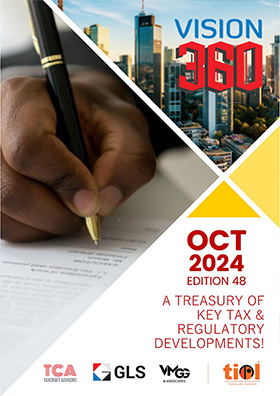PE Profits: HC Larger Bench to revisit Global Loss Attribution
JANUARY 30, 2024
By Karanjot Singh Khurana, Prachi Bhardwaj and Loveena Manaktala
 Background
Background
REVENUES earned by MNCs from India often remain under the lens of the Indian taxation authorities for examination of constitution of Permanent Establishment ('PE') in India and computation of profits attributable to such PE. The issue of attribution of business profits to a PE in a source country especially in case of losses at global level has been a subject matter of debate. This issue was somehow put to rest by the Delhi High Court in case of Nokia Solutions and Networks1, wherein it was held that no question of attribution of profits to PE arises in case the group has incurred losses at global level. However, recently the Delhi HC in Hyatt International Southwest Asia Limited2 expressed its prima facie disagreement with the erstwhile decision in Nokia Solutions and has referred the issue of attribution of profits to a Larger Bench. With this, the issue of attribution of profits in case of losses at the global level has once again gathered spotlight.
Analysis of existing jurisprudence
It all began with the Special Bench ruling in case of Motorola Inc.3 where the India specific accounts of PE had huge losses while the assessee on global level was making huge profits. The first appellate authority, in this case, rejected the accounts of the assessee and invoked Rule 10 of the Income Tax Rules, 1962 ('IT Rules') for calculation of the profits attributable to PE. The Special Bench upheld the methodology followed by the first appellate authority as per which the profit percentage was calculated based on global accounts and such profit percentage was thereafter applied on Indian sales to determine the profits attributable to PE in India.
Relying on the methodology upheld by the Special Bench ruling, the division bench of the Delhi ITAT in case of Nokia Solutions and Networks4 held that the net margins at global level are to be applied to calculate income attributable to PE in India, but the assessee having incurred global net loss as per its audited accounts, no profit or income can be attributed to its PE in India. The Delhi ITAT went a step ahead to justify the said reasoning by drawing a parallel with Article 7(1) of the applicable Double Taxation Avoidance Agreement ('DTAA'). Article 7(1) provides that 'profits' of a resident of a State shall be taxable only in that state. If, however, such an enterprise has a PE located in source state through which it carries on business then the portion of 'profit' as is attributable to PE may be taxed in the source state. By relying upon the language used in Article 7(1) of the DTAA, the ITAT essentially observed that attribution of profits to PE will arise only if foreign taxpayer is making a profit. The aforesaid decision in Nokia Solutions was also upheld by Delhi HC in subsequent department appeal5.
Seemingly, the essential principle of hypothetical independence of PE while attributing profits was not discussed in case of Nokia Solutions (supra) which is the essential principle of profit attribution envisaged in Article 7 of DTAA. The principle of hypothetical independence of PE is also to be followed when the attribution has to be made on the basis of apportionment of total profits as per customary methods of domestic law. This has been expressly made clear in some DTAAs like Article 7(4) of India Finland and India UAE DTAA.
If separate entity principle is applied, then as long as operations in source state are reasonably expected to make profits considering the functions performed, assets employed, and risk assumed by PE, then it may become immaterial that the foreign taxpayer has global losses. For example, there may be a case where Indian operations may have resulted in significant profits but owing to losses in other jurisdictions, the entity at global level may be incurring losses. In such a case, non-taxation of profits earned from India merely because foreign taxpayer has earned losses globally may not be correct. This was the prima facie reasoning of Delhi HC in Hyatt International as well. Even, the Commentaries on the Articles of the United Nations Model Double Taxation Convention between Developed and Developing Countries, 2017, has accorded same interpretation to Article 7 in following words:-
'8…
When referring to the part of the profits of an enterprise that is attributable to a permanent establishment, the second sentence of paragraph 1 refers directly to paragraph 2, which provides the directive for determining what profits should be attributed to a permanent establishment. As paragraph 2 is part of the context in which the sentence must be read, that sentence should not be interpreted in a way that could contradict paragraph 2, e.g. by interpreting it as restricting the amount of profits that can be attributed to a permanent establishment to the amount of profits of the enterprise as a whole. Thus, whilst paragraph 1 provides that a Contracting State may only tax the profits of an enterprise of the other Contracting State to the extent that they are attributable to a permanent establishment situated in the first State, it is paragraph 2 that determines the meaning of the phrase 'profits attributable to a permanent establishment'. In other words, the directive of paragraph 2 may result in profits being attributed to a permanent establishment even though the enterprise as a whole has never made profits: conversely, that directive may result in no profits being attributed to a permanent establishment even though the enterprise as a whole has made profits.'
Further, while the tax treaties provide an over principle of profit attribution, in the absence of any particular method of attribution in DTAA, Rule 10 of the IT Rules is also practically resorted to by taxation authorities to determine the profits attributable in India when the profits as declared in accounts are either rejected or are non-acceptable to the AO.
Rule 10 of the IT Rules provides following three options to AO for attribution of profit -
i. the presumptive method, i.e., at such percentage of the turnover so accruing or arising as AO may consider to be reasonable;
ii. the proportionate method, i.e., on any amount which bears the same proportion to the total profits and gains of the business of such person (such profits and gains being computed in accordance with the provisions of the Act), as the receipts so accruing or arising bear to the total receipts of the business;
iii. the discretionary method, i.e., in such other manner as the AO may deem suitable.
The powers given under Rule 10 are very wide. It is worth noting that the proportionate method (attribution of global profits) is only one of the three options provided under Rule 10. The fact that the foreign taxpayer may be at losses at global level will not be relevant especially if other methods provided under Rule 10 are resorted. Further, in light of the principle of profit attribution stated in the tax treaty, computation of profit attribution by applying proportionate method may also be questionable since the method may not always be consistent with the separate entity approach provided in DTAA. Further, the application of Rule 10 is a discretion of AO so it may also be contentious to conclude that the taxpayer has a vested right seeking application of proportionate method in Rule 10 in cases where there are losses at global level.
It was a matter of fact that Revenue authorities in Motorola Inc. (supra) had consistently applied proportionate method to arrive at gross profits relating to the sales made to Indian customers. From the gross profits, the revenue authorities had been attributing certain percentage of profits to the functions performed by Indian PE. However, the Hon'ble Delhi HC in the case of Nokia Solutions (supra) by placing reliance upon Motorola Inc. (supra) decision seemingly made a generic observation that Article 7(1) had the effect of restricting revenue to tax a PE in cases where the group was incurring losses at global level.
Also, the observation that Article 7 envisages attribution of only profits may not be correct as the fundamental legal position is that in India reference to 'income' has always been understood to include losses6. A reference to 'profits' in Article 7(1) may be interpreted by other forums at a similar footing.
Conclusion
Considering the international position, the decision of the Larger Bench of the Delhi HC is an eagerly awaited one for it is expected to settle a critical issue of attribution of profits to PE in case of global losses. The decision will have a major impact on start-ups outside India which may be incurring losses at global level and have significant presence in India for undertaking marketing of goods and services.
[The authors are Associate Partner, Principal Associate and Senior Associate, respectively, in the Direct Tax Team at Lakshmikumaran and Sridharan Attorneys, New Delhi]
____________
1 Revenue appeal arising from a Division Bench ruling of Delhi ITAT [2022] 97 ITR(T) 79]. The aforesaid ITAT ruling relied upon Special Bench ruling of Delhi ITAT in case of Motorola Inc. v. DCIT [TS-21-ITAT-2005(Del)] = 2005-TIOL-103-ITAT-DEL-SB
2 Hyatt International Southwest Asia Limited v. ACIT [TS-812-HC-2023(Del)] = 2024-TII-04-HC-DEL-INTL
3 Motorola Inc. v. DCIT [TS-21-ITAT-2005(Del)] = 2005-TIOL-103-ITAT-DEL-SB
4 Nokia Solutions and Networks OY v. ACIT [2022] 97 ITR(T) 79]
5 CIT v. Nokia Solutions and Networks OY [TS-960-HC-2022(DEL)] = 2022-TII-29-HC-DEL-INTL
6 CIT v. Gold Coin Health Food Pvt Ltd. [(2006) 304 ITR 308 (SC)] = 2008-TIOL-152-SC-IT
| (DISCLAIMER : The views expressed are strictly of the author and Taxindiaonline.com doesn't necessarily subscribe to the same. Taxindiaonline.com Pvt. Ltd. is not responsible or liable for any loss or damage caused to anyone due to any interpretation, error, omission in the articles being hosted on the site) |









 Background
Background




